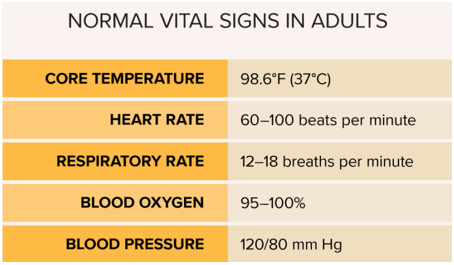The practical nurse (PN) finds a postoperative client lying in bed with an unsecured surgical dressing as seen in the picture. After reinforcing the dressing, which follow-up assessment is most important for the PN to implement?
Vital sign measurement.
Fluid volume intake and output.
Volume of peripheral pulses.
Incisional pain scale rating.
The Correct Answer is A
This is the most important follow-up assessment for the PN to implement because it can detect signs of bleeding, infection, or shock that may result from the unsecured surgical dressing. The PN should monitor the client's blood pressure, pulse, temperature, and respiratory rate and report any abnormal changes.

Nursing Test Bank
Naxlex Comprehensive Predictor Exams
Related Questions
Correct Answer is C
Explanation
The correct answer is choiceC. Health care proxy documentation.
Choice A rationale:
The name of the funeral home to contact is not immediately relevant during the admission assessment of a terminally ill client. This information can be collected later as part of end-of-life planning but is not critical for the initial assessment.
Choice B rationale:
While the contact information for the client’s next of kin is important for communication and support, it is not as crucial as health care proxy documentation for making immediate healthcare decisions.
Choice C rationale:
Health care proxy documentation is essential because it designates someone to make healthcare decisions on behalf of the client if they become unable to do so themselves.This ensures that the client’s healthcare preferences and decisions are respected and followed by the healthcare team.
Choice D rationale:
The client’s wishes regarding organ donation are important but are often included in the health care proxy documentation.This information is not as immediately critical as the health care proxy documentation during the admission assessment.
Correct Answer is D
Explanation
This is the factor that the PN should consider the most likely to increase the client's risk for falls because it can cause orthostatic hypotension, dizziness, or fainting, especially when the client changes position or gets up from bed or a chair. The PN should monitor the client's blood pressure and pulse before and after administering the medication and assist the client with ambulation and transfers.

A. An ankle ulcer that is healing slowly is not a major risk factor for falls and may not affect the client's mobility or balance.
B. History of alcohol abuse and cigarette smoking is not a major risk factor for falls unless the client is currently intoxicated or has a chronic lung disease that impairs oxygenation or cognition.
C. Recent weight gain of twenty pounds is not a major risk factor for falls unless it causes joint pain, edema, or difficulty moving.
Whether you are a student looking to ace your exams or a practicing nurse seeking to enhance your expertise , our nursing education contents will empower you with the confidence and competence to make a difference in the lives of patients and become a respected leader in the healthcare field.
Visit Naxlex, invest in your future and unlock endless possibilities with our unparalleled nursing education contents today
Report Wrong Answer on the Current Question
Do you disagree with the answer? If yes, what is your expected answer? Explain.
Kindly be descriptive with the issue you are facing.
